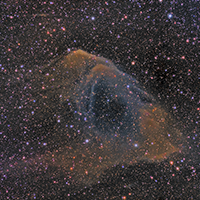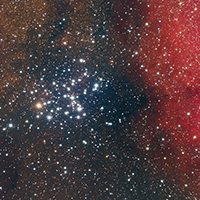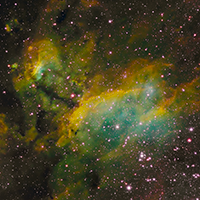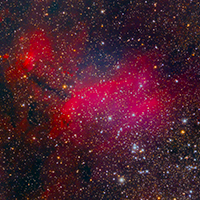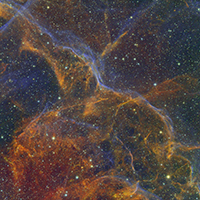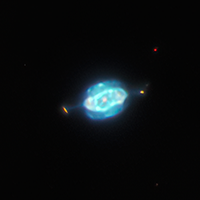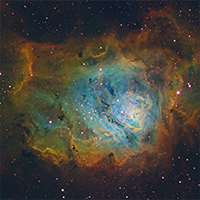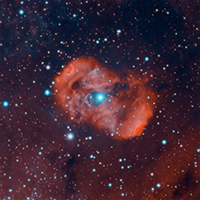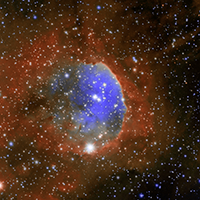Tagged: Emission Nebula
29-Sep-2022
When stars like the Sun are near end of life, they send their outer layers into space to create glowing clouds of gas, a planetary nebulae. This ejection of mass is uneven, and planetary nebulae can have complex shapes. This dying star is moving rapidly through space, resulting in a long tail of ionized hydrogen gas.
30-Mar-2022
Although categorised as a hydrogen emission nebula, Sh2-63 lacks the bright red colouring typical of similar objects.
26-Nov-2020
The Red Spider Nebula (also catalogued as NGC 6537) is a planetary nebula located near the heart of the Milky Way.
07-Jul-2019
The Butterfly Cluster, Messier 6, is an open cluster of hot blue stars with the brightest member being an orange giant star. Behind the cluster is the orange light of the Milky Way, and a beautiful cloud of excited Hydrogen alpha gas.
12-Feb-2019
The Skull & Crossbones Nebula is an active star-forming region approximately 20,000 light years away.
10-Aug-2018
IC 4628, sometimes known as The Prawn Nebula, is an emission nebula located around 6000 light-years away in the constellation Scorpius
10-Aug-2018
IC 4628, sometimes known as The Prawn Nebula, is an emission nebula located around 6000 light-years away in the constellation Scorpius
28-Jan-2018
The Vela Supernova Remnant is an expanding bubble of ionized gas 800 light years away, caused by a supernova explosion 12000 years ago. This image is a small section of the bubble, presented as a narrowband combination of light emitted by Hydrogen alpha, Sulfur II and Oxygen III.
11-Aug-2017
After a brief hiatus from astronomy to build a new, larger observatory, I've chosen another difficult target that was surprisingly bright.
15-Feb-2021
Stars such as our Sun do not contain enough mass to finish their lives in the glorious explosions known as supernovae. However, they are still able to salute their imminent demise into dense, Earth-sized embers called white dwarfs by first expelling colourful shells of gas known as planetary nebulae.
27-Sep-2020
The Saturn Nebula is a tiny but complex planetary nebula, ~4000 light years away in Aquarius. The Saturn Nebula gets its name from its resemblance to the planet Saturn to the observer.
27-Aug-2019
The Lagoon Nebula is an active stellar nursery spanning 60 light years across. This false color photograph shows the interplay of three gasses: hydrogen-alpha in green, sulfur-II in red, and oxygen-III in blue.
02-Jul-2019
4200 light years distant, NGC 6164 is a bipolar emission nebula was created by a massive O-type star, 40 times as larger than the Sun.
19-Jul-2018
Shaped like a cats paw, NGC 6334 is a stellar nursery and emission nebula 5,500 light years away in the constellation Scorpius. This image comprises of emission line data for Sulfur-II, Hydrogen-alpha and Oxygen-III, mapped to red, green, and blue respectively.
13-Mar-2018
The Gabriela Mistral Nebula lies close to the Carina Nebula ~7500 light years distant in the far-southern sky. This image is a narrowband representation showing glowing ionised gasses, Hydrogen-alpha (orange), Sulfur-II (red), and Oxygen-III (blue).
Page: 1, 2

